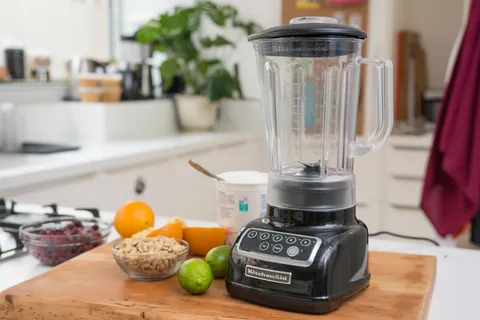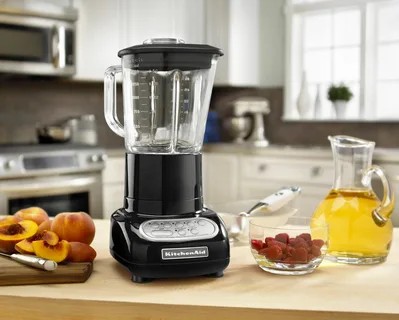Blenders are versatile kitchen appliances that can transform your cooking experience from mundane to extraordinary. Whether you’re looking to whip up a refreshing smoothie or create a hearty soup, blenders are a must-have tool in any kitchen. In this blog post, we will explore the various types of blenders, including electric and high-speed blenders, and how they can revolutionise your culinary creations. Get ready to blend your way to culinary greatness!
Understanding the Basics of Blenders
At the heart of many culinary adventures, blenders offer a convenient way to combine ingredients into smooth, homogeneous mixtures. A blender comprises a motorised base that propels blades at high speeds and is situated at the bottom of a jug or container. This setup is crucial for the appliance’s ability to puree, mix, and emulsify foodstuffs, allowing for various consistencies from liquid to semi-solid.
The beauty of using a blender lies in its simplicity – by adjusting the blending duration and manipulating the speed settings, one can effortlessly tailor the texture and consistency of the output to suit various recipes and preferences. Whether breaking down fibrous fruits for a smoothie or blending vegetables into a fine soup, understanding these basic operational principles is the first step towards mastering the art of blending.
 The Evolution of the Electric-Blender
The Evolution of the Electric-Blender
The journey of the electric-blender from a simple kitchen gadget to a sophisticated culinary tool is fascinating. Initially introduced to the market to assist with mundane tasks like mixing and pureeing, these appliances have undergone significant transformations. The early models were basic, offering a single speed and limited functionality. However, as technology advanced, so did the features of the electric-blender.
Today’s electric-blenders boast an array of functionalities that cater to the diverse needs of home cooks and professional chefs alike. Innovations have led to the inclusion of multiple speed settings, allowing users to fine-tune the texture and consistency of their creations with precision. The introduction of pulse functions provided an additional layer of control, enabling the chopping and mixing of ingredients without over-processing.
Furthermore, pre-programmed settings such as making smoothies, ice crushing, and soup blending have simplified the culinary process, allowing for consistent results with minimal effort. Manufacturers have also focused on the durability and efficiency of these devices. Modern electric-blenders have powerful motors that ensure longevity and performance and handle various ingredients, from soft fruits to hard nuts.
Choosing the Best Blender for Your Kitchen
Selecting the best blender for your kitchen hinges on assessing your culinary needs and preferences. The blender’s capacity is paramount; a giant jug might be more suitable for families or those who entertain frequently, whereas a compact model is perfect for individuals or small spaces. The motor’s power, measured in watts, directly impacts the blender’s efficiency in processing harsh ingredients like frozen fruit or nuts.
A model with a robust motor will ensure smoother outcomes and a longer lifespan. Blade design also plays a crucial role. Stainless steel blades are preferred for their durability and ability to maintain sharpness over time. For versatility, opt for a blender that offers a range of speed settings. This flexibility allows precise control over texture, whether making a chunky salsa or a velvety smoothie.
Some blenders also feature pre-set programmes, simplifying tasks such as crushing ice or making soup. The ease of cleaning is a consideration that should be noticed. Blenders with detachable parts can make cleanup a breeze, and dishwasher-safe components are a bonus. By considering these factors, you can find a blender that meets your culinary requirements and fits seamlessly into your kitchen routine.
The Magic of High-Speed Blenders
High-speed blenders are at the forefront of kitchen technology, equipped with motors that deliver unparalleled power and blades engineered for precision. This combination allows them to tackle vast ingredients, converting them into the smoothest textures with remarkable ease.
The capability of these machines to operate at such intense speeds means they can break down fibres in fruits and vegetables more efficiently than standard blenders, ensuring that your smoothies, soups, and sauces are not only silky but also nutritionally superior. The speed at which these devices work also introduces a new dimension to cooking – the ability to heat ingredients through friction, making them ideal for preparing homemade soups and warm beverages without needing a hob.
With a high-speed blender, culinary tasks that once seemed laborious or impossible are now within easy reach, allowing both novices and seasoned chefs to explore new horizons in food preparation. Their robustness and efficiency stand out, making them a worthy investment for those who value quality and versatility in their kitchen appliances.
Delicious Recipes to Make With Your Electric Blender
Your electric-blender is the key to unlocking a treasure trove of culinary delights extending far beyond smoothies and soups. Embrace the art of creating sauce by blending tomatoes, fresh herbs, and olive oil for a rustic pasta accompaniment. Venture into the world of desserts with a silky chocolate mousse made from blended avocados for an unexpectedly smooth texture, or prepare homemade nut butter by pulverising almonds or cashews into a creamy spread.
For a refreshing treat, try frozen yoghurt, combining Greek yoghurt with your choice of fruits and a drizzle of honey before freezing. Don’t stop experimenting with dressings and marinades either; a quick blend of citrus juice, spices, and oil can elevate any salad or dish. The possibilities with your electric blender are boundless, inviting you to explore and refine your culinary skills with every blend.
Maintenance Tips to Keep Your Blender in Top Shape
Ensuring your blender remains in prime condition requires regular maintenance and careful handling. By adhering to the following guidelines, you can extend the lifespan of your appliance and maintain its efficiency:
Clean Promptly After Use
Immediately washing your blender after each use prevents residues from hardening, which can be more challenging to clean later and may harbour bacteria. Rinse the jug and blades under warm water, and use a soft brush or sponge with mild detergent to clean them thoroughly.
Regularly Inspect Blades and Gasket
Over time, your blender’s blades can become dull, and the gasket (the rubber seal at the base of the jug) may wear out or get damaged. Check these components regularly for any signs of wear and tear. Replacing them when necessary can prevent leaks and ensure your blender continues to operate effectively.
Deep Clean Monthly
Aside from daily cleaning, performing a deep clean once a month is beneficial. Fill the blender halfway with warm water, add a drop of washing-up liquid, and blend on high for a minute. This helps remove any leftover particles or grease.
Store Properly
After cleaning and drying:
- Reassemble your blender and store it in a dry, cool place.
- If possible, keep the jug inverted on the base to prevent any water from pooling and causing damage.
- Avoid storing the blender with heavy items on top, as this can misshape the jug or lid, leading to improper sealing during use.
Blend Like A Pro with Expert Tips
Unlock your blender’s full potential and elevate your culinary creations with these expert tips designed to enhance your blending technique. Firstly, add liquids (such as water, milk, or juice) to the jug for smoother blends before adding solid ingredients. This step helps create a vortex, ensuring your solids are pulled towards the blades more efficiently.
Layering is vital; place softer, high-moisture items like tomatoes or oranges at the bottom and denser fruits and vegetables, and add ice or frozen ingredients on top. This stratagem ensures an even blend and protects the blades from undue stress. Pulsing can be your best friend, especially when dealing with chunky or difficult-to-blend items. It provides the necessary jolt to move pieces around without overworking the motor.
If your blender struggles with larger chunks, pause periodically to stir the contents or use a tamper (if your blender comes with one) to push ingredients towards the blades. Temperature matters – blending warm ingredients can help release their natural aromas and flavours, enhancing the overall taste of soups and sauces. However, always be cautious with hot liquids, as expanding steam can cause pressure build-up.
Blend Your Way to Better Health – High Speed Blender
Embracing a high speed blender in your culinary toolkit opens the door to many healthful possibilities. Such appliances are adept at crafting nutrient-dense beverages and meals that align with a wholesome lifestyle. Imagine kick-starting your day with a vibrant green smoothie, where kale, spinach, and other leafy greens are combined with fruits to create a drink brimming with vitamins and antioxidants.
Or, consider the simplicity of making your nut milk – almond, cashew, or oat – free from the additives and preservatives found in shop-bought versions. For those pursuing a plant-based diet, high-speed blenders make it effortless to prepare creamy soups and sauces, ensuring the whole spectrum of available nutrients nourishes you.
Even making whole-grain flour or fresh, preservative-free nut butter becomes easily accomplished. The power and speed of these blenders ensure maximum nutrient extraction, meaning you get more of the good stuff from your ingredients. As you explore the capabilities of your high-speed blender, you’ll find that achieving a balanced, health-focused diet is feasible and enjoyable.
Conclusion
In essence, the journey through the blender world illustrates their pivotal role in modern kitchens and their potential to enhance our culinary practices and dietary habits. From the evolution of electric-blenders to the revolutionary capabilities of high-speed variants, these appliances empower us to quickly explore various recipes and techniques. By selecting the right blender, maintaining it diligently, and applying expert tips, we can unlock a universe of flavours and textures, making every meal an opportunity to blend creativity with nutrition.
FAQs
Is it safe to blend hot ingredients directly in my blender?
Directly blending very hot ingredients in a blender can be unsafe due to the build-up of steam, which increases internal pressure and could potentially force the lid off. To mitigate this risk, allow the ingredients to cool for a few minutes before blending, or use a blender specifically designed to handle hot liquids with a vented lid for steam release.
What is the most effective way to clean my blender?
Cleaning your blender is straightforward—disassemble the jug from the base, remove the blades if possible, and then wash them in warm, soapy water. A soft brush can help remove stubborn residues. For a deeper clean, particularly for eliminating odours or stains, blend water with a small amount of baking soda or vinegar, ensuring you thoroughly rinse afterwards to remove any cleaning solution residue.
Can my blender crush ice effectively?
Most modern blenders are designed to crush ice; however, the ability to do so without compromising the blades or motor varies by model. It is advisable to consult your blender’s user manual to confirm if your model is suitable for ice-crushing. Blenders with powerful engines and specially designed blades are more effective and durable when processing ice.
| Other Good Articles to Read |
| Blogs Rain |
| Cme Blog Spot |
| Garcias Blogs |
| Yyc Blogs |
| Blogs-Hunt |
| Impact-Blog |
| Smarty Blogs |
| Ed Blog |
| Mo Blogs |
| Blogs Em |
| Blogs T |
| Related Business Listings |
| Contact Directory |
| Local Business Profiles |



